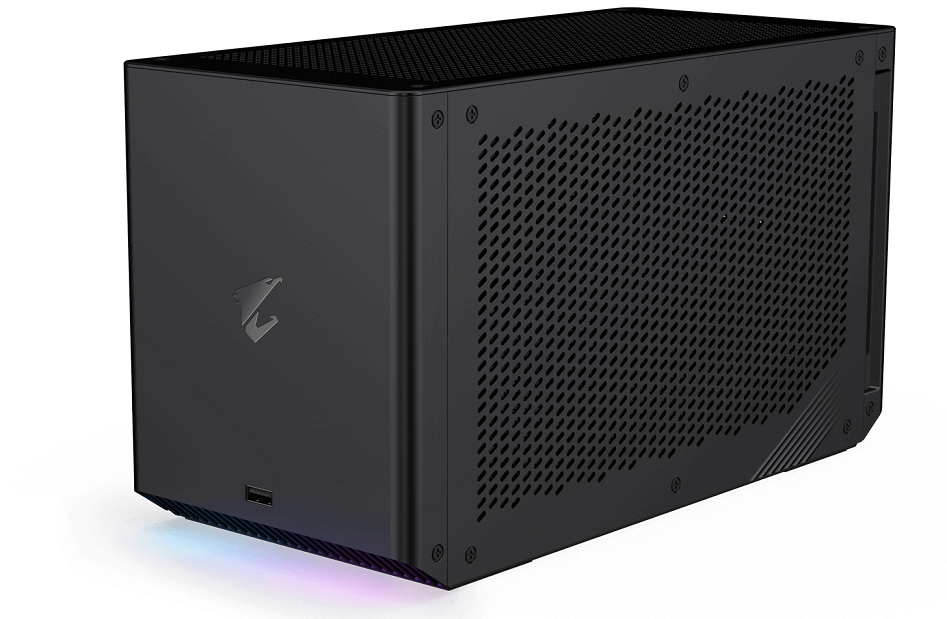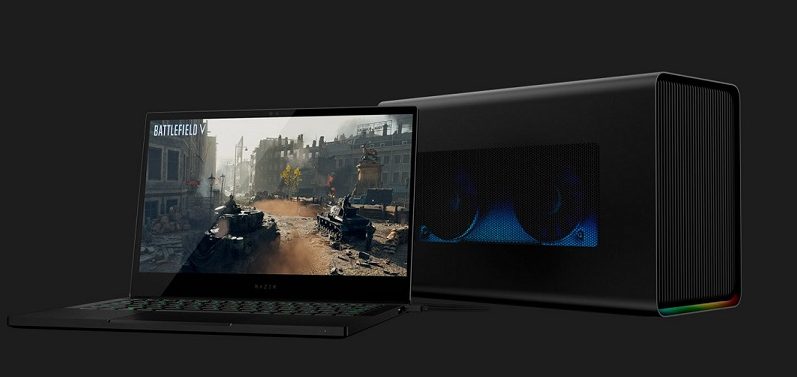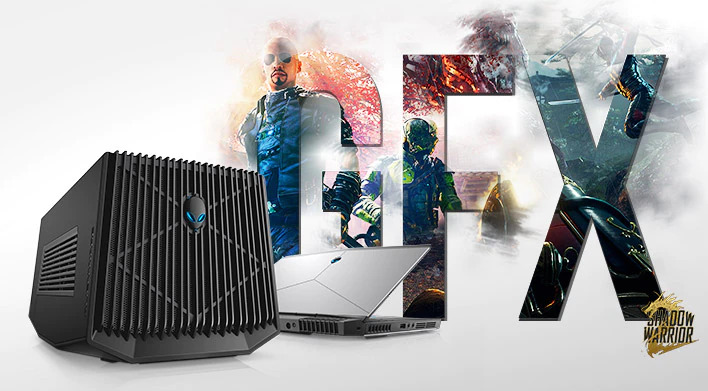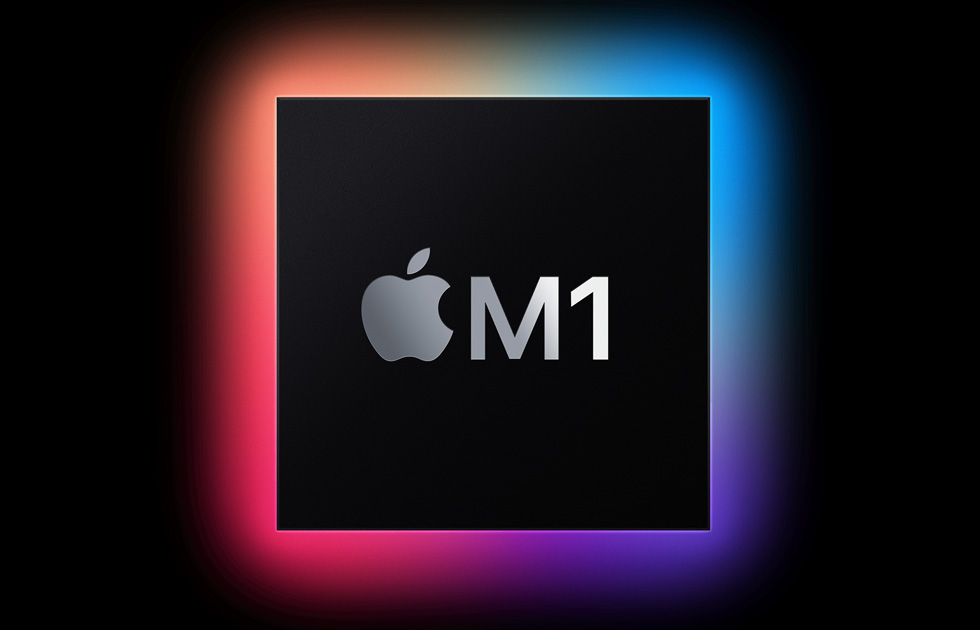It’s 2022 and with the unpredictable prices of graphics cards rising since the beginning of the pandemic, the question of whether getting an eGPU is really worth it comes to mind.

Before we get into that, let’s start with a simple explainer about eGPUs? An eGPU is an external graphics processing unit. Unlike the regular GPUs plugged directly into the motherboard via PCIe slots, eGPUs work outside of the entire system via a Thunderbolt 3 or 4 USB-C cable. These normally end up on systems that don’t advertently accept a regular graphics card.
In most cases, external GPUs are hooked to a dock. With a dock, installation of the card and drivers followed by a reboot of the system, will typically get the card working. Once set up, the laptops route requests to the external GPU instead of the default shared graphics card inside. In theory, the external GPU should give better graphical performances and theoretically boost FPS for gameplay or rendering times for animation or post-processing work.
Using an external GPU may sound all-fancy and nice but going into more detail, it won’t give you the same performance as it would if the GPU were mounted internally or directly into a PCIe port. The loss of performance is estimated at around 10 to 15 percent. If it’s going to be used for gaming, the difference would hardly be noticeable. If the purpose is for video rendering and post-processing, there might result in a faster operation, perhaps a few minutes difference.

Despite that, most laptops are not designed to handle so much power. There are also a few units coming out that provide enough discreet GPU power to accommodate AAA games, which again negates the need for an external GPU. In terms of cost, an ASUS Zenbook Pro Duo powered by Intel Core i9-11900H, 32GB RAM, 1TB storage NVMe PCIe 4.0 with RTX 3080 8GB GDDR6 can be purchased for Php209,995USD 3,578INR 303,359EUR 3,408CNY 26,060.

Meanwhile, the Razer Core X Chroma 16 can be had for USD399.99PHP 23,474INR 33,899EUR 381CNY 2,911 (official website price) with an Nvidia GeForce RTX 2080Ti (excluding shipping).
Locally, the AORUS Gaming box is available for around Php90,000USD 1,534INR 130,014EUR 1,461CNY 11,169 with an RTX 3080 graphics card. If paired with an Asus VivoBook S14 equipped with an Intel Core i5-1135G7, 16GB RAM,512GB SSD, Intel Iris Xe Graphics, Windows 10 at Php49,995USD 852INR 72,223EUR 811CNY 6,204 we feel would be better off choosing the ASUS Zenbook Pro Duo to maximize the extra features, graphics card, and well, portability.

Getting an eGPU requires some intense research as well. There is a variety of models in the market with different compatibilities and features, some of which concern size, length, and connectors. While most have a Thunderbolt connection, others like Alienware’s Graphics Amplifier don’t have any USB or Thunderbolt ports but use a proprietary connector instead. The same goes with the HP Accelerator Omen which has a SATA port for connecting an additional HDD or SSD.

Compatibility between the dock and the card is also a very big deciding factor as products like the ASUS ROG XG Station 2 will only work with up to their current generation of GPUs which would most likely mean that should you want to upgrade your GPU, then another upgrade for the dock will be necessary. Although ASUS has released the ASUS XG Mobile, those are only compatible with the ASUS Flow series. Speaking of compatibility, Apple has released a support page that states only Macbooks with Intel processors would be able to utilize an eGPU.

Despite all the drawbacks, it will definitely get users better graphic performance out of their laptops and enable a more immersive gaming experience compared to their standard integrated GPU chips. Quite a number of benchmarks have already shown that external GPUs offer a boost in performance. Additionally, it is quite difficult to create a definitive guide as to how much boost external GPUs offer since it would depend on the systems being used.
With all the thoughts on this article, buyers should have a general idea of what to expect when buying an external graphics card as well as its pros and cons. It will definitely be a sizeable investment but that would then boil down to its use case. Though we feel that laptops were made to be portable and the addition of an external graphics card in the bag pretty much defeats the purpose. Lastly, an external graphics card for a laptop will face restriction when used with older software and a heads-up may be necessary that you may experience some compatibility and wonky experience.
All in all, if you have the budget, just go for it. If asked, creators and editors mostly will end up benefiting from external graphics cards. Give or take, those who have already invested in laptops 3 years ago, and need the graphic boost now, as well as those video editors that would require faster rendering times on software like Adobe Premiere, Adobe After Effects, Da Vinci, and the like. On the other hand, if the laptop in question is 5 generations behind, we highly suggest to just upgrade the entire system altogether as it is either outdated or cannot support an external graphics card at all.
Let us know if we’ve missed some great points that should be on here.

YugaTech.com is the largest and longest-running technology site in the Philippines. Originally established in October 2002, the site was transformed into a full-fledged technology platform in 2005.
How to transfer, withdraw money from PayPal to GCash
Prices of Starlink satellite in the Philippines
Install Google GBox to Huawei smartphones
Pag-IBIG MP2 online application
How to check PhilHealth contributions online
How to find your SIM card serial number
Globe, PLDT, Converge, Sky: Unli fiber internet plans compared
10 biggest games in the Google Play Store
LTO periodic medical exam for 10-year licenses
Netflix codes to unlock hidden TV shows, movies
Apple, Asus, Cherry Mobile, Huawei, LG, Nokia, Oppo, Samsung, Sony, Vivo, Xiaomi, Lenovo, Infinix Mobile, Pocophone, Honor, iPhone, OnePlus, Tecno, Realme, HTC, Gionee, Kata, IQ00, Redmi, Razer, CloudFone, Motorola, Panasonic, TCL, Wiko
Best Android smartphones between PHP 20,000 - 25,000
Smartphones under PHP 10,000 in the Philippines
Smartphones under PHP 12K Philippines
Best smartphones for kids under PHP 7,000
Smartphones under PHP 15,000 in the Philippines
Best Android smartphones between PHP 15,000 - 20,000
Smartphones under PHP 20,000 in the Philippines
Most affordable 5G phones in the Philippines under PHP 20K
5G smartphones in the Philippines under PHP 16K
Smartphone pricelist Philippines 2024
Smartphone pricelist Philippines 2023
Smartphone pricelist Philippines 2022
Smartphone pricelist Philippines 2021
Smartphone pricelist Philippines 2020
b1twise says:
The problem with current x86 laptops is thermals/power consumption. If you move to a laptop with a high end dGPU setup, usually the battery life is extremely poor. I read a review of a new MSI laptop yesterday that only got 75 minutes of battery use. This makes your laptop more of a portable computer tethered to an outlet. However, you might have a laptop for work that doesn’t need the extra graphics capabilities, but when you get home you want to game. This allows you to choose something with a much better battery life during the day. The logical use cases are rare, but they do exist. You should never use one with a proprietary connector, though. Proprietary connectors are just bad. There’s also the reverse case where you need to do GPU intensive data processing at work, but still have a portable machine. I think the usual case for an eGPU is an addon to an existing laptop vs a new purchase. eGPUs do not also have to route video back to the computer. Displays can be connected directly to the card, and this reduces the overhead.